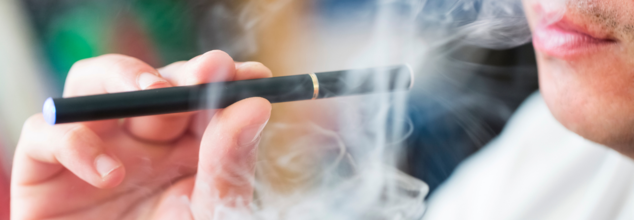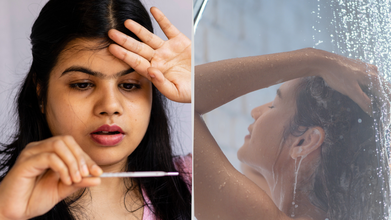- Health Conditions A-Z
- Health & Wellness
- Nutrition
- Fitness
- Health News
- Ayurveda
- Videos
- Medicine A-Z
- Parenting
World No Tobacco Day 2025: How “Safe” Vaping Is Hooking A New Generation On Nicotine?

Credits: Canva
Every year on May 31, World No Tobacco Day serves as a global wake-up call to the grave dangers of tobacco consumption. Initiated by the World Health Organization (WHO) in 1987 and formalized in 1988, this day aims to highlight the health risks associated with tobacco use and push for effective policies to reduce its consumption. This year’s theme, “Unmasking the Appeal: Exposing Industry Tactics on Tobacco and Nicotine Products,” takes a bold stand against deceptive marketing strategies that present vaping and other nicotine products as “safer” alternatives to traditional tobacco.
This narrative, although seductive, is not just misleading—it’s dangerous.
Also Read: World No Tobacco Day 2025 Theme
Why Vaping is Seen as a “Healthier” Substitute?
Public health campaigns had, for a while, reason to celebrate. Decades of anti-smoking efforts were showing results, with fewer people lighting up cigarettes. The drop in cigarette smoking was hailed as a victory for preventive healthcare. But the rise of e-cigarettes—sleek, flavored, and aggressively marketed—has reversed some of that progress.
Originally touted as a cessation aid or a “less harmful” nicotine delivery method, vaping quickly evolved into a cultural trend, especially among youth. While traditional smoking rates declined, vaping became the most common method of nicotine consumption among adolescents, replacing rather than eliminating tobacco use.
“Vaping is not harmless,” warns Dr. Arun Chowdary Kotaru, Head and Senior Consultant of Pulmonology & Sleep Medicine. “Even if it may contain fewer toxic chemicals than traditional cigarettes, it still delivers a cocktail of harmful substances that are anything but safe.”
At the heart of both smoking and vaping is nicotine—a highly addictive stimulant that alters brain chemistry. E-cigarettes typically contain this substance, which, according to the Centers for Disease Control and Prevention (CDC), not only fuels addiction but also impairs adolescent brain development.
“The teenage brain is still developing until around the age of 25,” explains Dr. Kotaru. “Nicotine interferes with areas responsible for learning, impulse control, and mood regulation. Early exposure can also set the stage for a lifelong struggle with addiction, increasing vulnerability to other substance abuse later in life.”
It’s not just youth who are affected. Pregnant women who vape put their unborn children at risk, as nicotine restricts blood flow to the placenta, potentially leading to low birth weight and other complications.
What’s in a Vape?
Many people assume that switching from cigarettes to vaping means fewer chemicals entering the body. That’s not entirely accurate. While e-cigarettes may contain fewer carcinogens than combustible cigarettes, the aerosol (not vapor) inhaled from vaping devices contains a toxic mix.
According to the CDC and corroborated by Dr. Kotaru, this aerosol may include:
- Heavy metals like lead, nickel, and tin
- Volatile organic compounds that are linked to cancer
- Flavoring chemicals, notably diacetyl, associated with “popcorn lung” or bronchiolitis obliterans
- Ultrafine particles that can be inhaled deep into the lungs
“Inhaling these substances directly into the lungs introduces not just nicotine, but also numerous potentially carcinogenic and lung-damaging compounds,” Dr. Kotaru adds. “This is not harm reduction—it’s harm diversification.”
Are Flavors and Packaging Hooking the Next Generation?
One of the most alarming strategies employed by the vaping industry is flavoring. Youth-friendly flavors like mango, cotton candy, and mint make vaping palatable—and appealing—to teenagers and young adults. As of late 2023, over 6,000 vaping products were available in the U.S., many in disposable formats that are brightly colored and easy to conceal.
These products are not just accessible—they're marketed with the kind of sophistication once seen in cigarette advertisements from the 1950s and ’60s, before regulation cracked down. The industry's tactics seem designed to normalize vaping, glamorize nicotine, and downplay the risks.
Myth of “Harm Reduction” and Dual Use
Proponents of vaping often cite “harm reduction” as a justification, suggesting that e-cigarettes are a stepping stone to quitting. While this may hold true for a subset of adult smokers under medical guidance, the reality is more complicated.
Dual use—where individuals both vape and smoke traditional cigarettes—is increasingly common. This behavior does not reduce harm but rather amplifies exposure to toxic chemicals. According to public health experts, dual users may suffer worse respiratory outcomes compared to those who stick to one method alone.
“People assume they're cutting down on cigarettes by vaping,” says Dr. Kotaru. “But in reality, they’re compounding the risk by layering one addiction on top of another.”
Campuses across the U.S. are grappling with the rising incidence of vaping among students. Once confined to restrooms and dorm rooms, the use of e-cigarettes has crept into classrooms, cafeterias, and even public events.
Behavioral health reports from school districts, such as the 2024 Wood County Youth Behavioral Health Barometer, indicate that vaping is often seen as harmless among teens—a perception that public health advocates are racing to correct. Educational campaigns are now targeting youth directly, enlisting students in peer-led interventions to counteract the flood of misinformation on social media and among friends.
“Safer” Doesn’t Mean Safe
The narrative that e-cigarettes are a “safer” alternative to smoking needs to be critically examined and, in many cases, flatly rejected. Public health isn’t a race to the lesser of two evils. It’s a pursuit of well-being grounded in evidence, prevention, and transparency.
While vaping may have a role in helping some adult smokers transition away from combustible tobacco under strict supervision, the broad marketing of these devices—especially to youth—is a threat to global health.
On this World No Tobacco Day, let’s unmask the illusions, expose the tactics, and recommit to a nicotine-free future. The risks are real. The science is clear. “Safer” isn’t safe—and we should stop pretending otherwise.
Dr. Arun Chowdary Kotaru, Head and Senior Consultant, Pulmonology & Sleep Medicine, Artemis Hospitals
Scromiting: Unusual Symptom Caused By A Deadly Cannabin Condition; All You Need To Know

Credits: iStock
Scromiting is taking up the space in headlines now. Before 2025 comes to an end, this single symptom caused by a deadly cannabis condition has got everyone talking about it.
The deadly cannabis hyperemesis syndrome (CHS), is now formally designated by the World Health Organization (WHO), and the unique and unusual symptom is scromiting: a mix of screaming and vomiting. Thanks to social media, this word is making a buzz and have distorted what people should actually know about the condition.
The WHO has formally named CHS in October, which was after a decision adopted by the Centers for Disease Control and Prevention (CDC) that will help doctors track the prevalence of the condition and get a better picture of adverse events.
Scromiting and CHS: How Did It Make A Big News?
The conversation reignited after a study published in the Journal of the American Medical Association in late November reported that CHS cases remain elevated. The study noted that cyclic vomiting is a related symptom and confirmed that emergency department visits tied to CHS saw a notable rise between 2016 and 2022, particularly in 2020 and 2021. During those two years, researchers identified 188 million emergency department visits among adults aged 18 to 35, with CHS appearing more frequently among heavy cannabis users.
The Origin Of CHS
CHS was first identified in Australia in 2004, yet nearly two decades later it remains poorly understood. It typically affects people who use marijuana daily or near daily for more than a year, leading to episodes of severe nausea, repeated vomiting, abdominal pain and a compulsive desire to take extremely hot showers or baths. Many patients report that heat temporarily eases their symptoms, although doctors say the relief is often short-lived.
What Are The Doctors Saying?
Dr Sam Wang, a pediatric emergency medicine specialist and toxicologist at Children’s Hospital Colorado, described treating patients who arrive exhausted and doubled over in pain after hours of vomiting, as reported by CNN. Many tell doctors they tried taking a scalding hot shower before coming to the hospital but found it offered little relief. The National Institutes of Health has said this hot water reliance appears to be a learned behavior that can become a compulsion.
Despite the surge in awareness, the term “scromiting,” a blend of screaming and vomiting, has sparked its own controversy. Some social media users argue the sudden buzz is exaggerated or anti-cannabis fearmongering. Others say the phenomenon has been known for years. Natashia Swalve, a neuroscience professor at Grand Valley State University, told Axios that “scromiting” is not a clinical term, just a catchy label that gains traction every few years. She warned that sensational language fuels confusion at a time when misinformation about CHS is already widespread.
Health experts say CHS episodes can last for days and recovery may take weeks or even months, depending on overall health, eating habits and whether the person stops using marijuana. Continuing to use cannabis can quickly trigger symptoms again. A study from George Washington University found that nearly half of surveyed patients had been hospitalized at least once because of CHS, and many reported using marijuana more than five times a day before symptoms began. Starting cannabis at an early age was linked to a higher likelihood of developing the condition.
The renewed scrutiny of CHS comes as the United States faces rising infections from norovirus, sometimes called “winter vomiting disease,” another illness known for causing sudden, intense vomiting. While unrelated, the overlapping symptoms have added to public confusion around what exactly is driving widespread reports of stomach distress.
Researchers emphasize that CHS is real, although many questions remain unanswered, including why hot showers feel soothing and how much cannabis use puts someone at risk. They say more clinical awareness is urgently needed. Better screening for cannabis use and recognizing symptom patterns could help reduce misdiagnosis and guide patients toward the only proven treatment: stopping marijuana use.
Why Women Love To Take Very Hot Shower, According To Doctor

Credits: iStock
For years, people have joked about how women seem to enjoy showers that could probably cook noodles. If you are someone who loves cranking up the water temperature until the bathroom looks like a steam room, you may have wondered whether there is an actual reason behind it. According to UK surgeon and content creator Dr Karan Rajan, the answer lies in biology. Women are not simply choosing scalding showers for fun. Their bodies are wired differently, and that affects how they experience temperature.
Higher Core Body Temperature
Dr Rajan explains that, on average, women have a slightly higher core body temperature than men. It might sound like this would keep them warmer, but in reality, it does the opposite. When the core is warm but the surrounding environment is cool, that contrast makes cold air feel even colder. So a mildly chilly room may feel more uncomfortable for women, leading them to turn to hotter showers to compensate.
This idea has gone viral online. In a popular TikTok clip, creator couple Micah and Sarah joked about preparing for a shared shower. Micah pretended to train for the extreme heat by dipping his hand in boiling water. The internet quickly chimed in with comments like “My husband says I am training for hell” and “He calls it lobster time”. The jokes were relatable because many couples experience this temperature divide, but not many knew the science behind it until now.
Hormones Add to the Chill
Hormones play a major role too. Estrogen affects blood flow to the extremities, which includes hands, feet and even earlobes. Research shows that women’s extremities can be up to three degrees colder than men’s. Dr Rajan points out that this becomes more noticeable during ovulation when estrogen levels peak. Women on hormonal birth control may also experience increased sensitivity because estrogen stays higher for longer periods.
So even when the core stays warm, the toes and fingers may feel unusually cold. A very warm shower becomes a quick and comforting fix for this temperature imbalance.
Lower Metabolic Rates
Another biological factor is metabolic rate. Women generally have a lower resting metabolic rate than men, meaning they produce less body heat throughout the day. This naturally makes them feel colder and more drawn to hotter water while bathing. Women also tend to have more body fat and less muscle mass, which influences how the body responds to temperature changes.
What Doctors Say
Australian GP Dr Jasmina Dedic Hagan supports these findings, as reported in Body and Soul. She explains that women typically have warmer cores, cooler skin, and a higher layer of insulating fat around the body. On top of that, they have reduced circulation in the extremities because the body prioritises keeping reproductive organs warm. With less muscle mass, the body’s heat-producing brown fat does not function in quite the same way as it does in men.
So Is It Just Preference?
Not entirely. While some women truly enjoy the sensation of a very hot shower, much of it is tied to biology. From hormones to metabolism to circulation, several factors work together to make warmer showers feel soothing and sometimes even necessary. So the next time someone teases you about loving lava-level water, you can tell them it is simply science at work.
Should I Take A Shower When I'm Sick?

Credits: iStock
When you are burning up, even a simple shower can feel confusing. Should you cool your body quickly with cold water or soothe your aches with something warm? Fever is a natural defense mechanism, but the symptoms it brings can make you feel miserable. The right water temperature can help ease discomfort and support your recovery.
Below is a simple breakdown of how fever affects your body, followed by practical shower tips and additional ways to safely bring your temperature down.
How Fever Resets Your Body’s Thermostat
During an infection, your immune system releases chemicals called pyrogens. These signals tell the hypothalamus, which is your internal thermostat, to raise your core temperature. The added heat slows the growth of certain viruses and bacteria and helps immune cells work more efficiently.
This temperature rise is why you feel:
- Chills as your body works to reach the new set point
- Sweating when the fever begins to settle
- Faster heart rate and quicker breathing, which increase fluid loss
Knowing this matters because water that is too cold can trigger intense shivering, which drives your temperature higher. Water that is too hot can widen your blood vessels and increase sweating, which may worsen dehydration.
Cold, Lukewarm, or Hot: Which Shower Helps Most?
Each water temperature works differently with a fever. Understanding these differences helps you choose what your body needs at that moment.
Cold showers cool your skin quickly. They may feel refreshing if you are overheated, but they often trigger shivering. That shivering can raise your core temperature and is especially risky in children.
Lukewarm or tepid showers are the safest choice for most people with fever. This temperature allows gentle heat loss through the skin without causing shivering. It helps you cool down gradually while keeping your body comfortable.
Warm or hot showers can help relieve muscle aches or sinus congestion, especially for adults. However, they can increase sweating and may slightly raise your temperature. Avoid them if you are already overheated or dehydrated.
Simple Shower Tips When You Have a Fever
- Start with lukewarm water to safely reduce temperature and ease discomfort.
- If you feel flushed and sweaty, splash cold water only on pulse points such as the wrists and neck.
- Use warm showers only for congestion relief and follow up with hydration and light clothing.
- If you feel dizzy, sit on a chair outside the shower and let steam fill the bathroom while you take a gentle sponge bath.
Other Safe Ways to Bring Down a Fever
Rest
Your body is already working hard to fight the infection. Light activity can raise your temperature further, so give yourself time to rest and recover.
Stay Hydrated
Fever increases the risk of dehydration, especially if you have vomiting or a poor appetite. Sip water, oral rehydration solutions, or electrolyte drinks. Chilled fluids can also help lower your temperature.
Stay Cool
Keep your room slightly cool and wear loose, breathable clothing. If you have chills, use a light blanket but avoid overheating. You can place a cool cloth on your forehead or under the arms for short intervals.
Medication
Over the counter fever reducers like acetaminophen and ibuprofen can safely lower fever. Always follow dosage guidelines. Avoid aspirin in children because it can lead to Reye's syndrome.
What Not to Do
- Do not take cold showers or ice baths because they trigger shivering and can raise your temperature.
- Avoid alcohol rubs since the alcohol can be absorbed through the skin.
- Do not take extra doses of fever medicine thinking it will work faster.
- Always read medication labels carefully to avoid accidental overdosing.
© 2024 Bennett, Coleman & Company Limited

